Standard [CURRENT]
ASTM F 2033:2025
Standard Specification for Hip Joint Replacement Bearing Surfaces
- Publication date
- 2025
- Original language
- English
- Pages
- 8
- Publication date
- 2025
- Original language
- English
- Pages
- 8
- DOI
- https://dx.doi.org/10.1520/F2033-25
Product information on this site:
Quick delivery via download or delivery service
Buy securely with a credit card or pay upon receipt of invoice
All transactions are encrypted
Short description
1.1 This specification covers the requirements for the mating bearing surfaces of total hip joint replacements and separate requirements for dual mobility hip joint replacements, intended for total hip arthroplasty; and partial hip joint replacements and separate requirements for bipolar femoral hip joint replacements, intended for hemiarthroplasty. All joint replacement implant types are defined in ISO 21535. More specifically, this specification covers hip joint replacement of the ball-and-socket configuration. 1.2 This specification covers the requirements for the visual inspection, sphericity, surface finish, and dimensional tolerances for the spherical articulating metal or ceramic femoral heads of total hip joint replacements. 1.3 This specification covers the requirements for the visual inspection, surface finish, and dimensional tolerances for the spherical concave mating surface of polyethylene acetabular components; and the requirements for the visual inspection, sphericity, surface finish, and diametral clearance for the spherical concave mating surface of metal and ceramic acetabular components of total hip joint replacements. 1.4 This specification covers the requirements for the visual inspection, sphericity, surface finish, and dimensional tolerances for the spherical metal or ceramic femoral heads of partial hip joint replacements. 1.5 This specification covers the requirements for the visual inspection, sphericity, surface finish, and dimensional tolerances for the spherical articulating metal or ceramic femoral heads of bipolar femoral hip joint replacements; the requirements for the visual inspection, surface finish, and dimensional tolerances for the inner polyethylene bearing surface of bipolar heads; the requirements for the visual inspection, sphericity, surface finish, and diametral clearance of the inner metal or ceramic bearing surface of bipolar heads; and the requirements for the visual inspection, sphericity, surface finish, and dimensional tolerances of outer metal or ceramic bearing surfaces of bipolar heads of bipolar femoral hip joint replacements. 1.6 This specification covers the requirements for the visual inspection, sphericity, surface finish, and dimensional tolerances for the spherical articulating metal or ceramic femoral heads of dual mobility hip joint replacements; the requirements for the visual inspection, surface finish, and dimensional tolerances for the inner polyethylene bearing surface of dual mobility heads; the requirements for the visual inspection, sphericity, and surface finish of outer polyethylene bearing surface of dual mobility heads; and the requirements for the visual inspection, sphericity, surface finish, and diametral clearance requirements for the spherical concave mating surface of metal and ceramic acetabular components of dual mobility hip joint replacements. 1.7 This specification covers requirements for metal femoral heads and the bearing surfaces of metal femoral heads, which can be as-machined (e. g., ground and polished), or which can be additionally treated by surface hardening, or which can be treated by coating with thin ceramic layers or by chemical transformation of a thin surface zone into a ceramic. Due to the way they are fabricated, the metal heads with additional surface treatment can only meet the requirements for metal heads without any surface treatment. These are not ceramic heads even if their surface might be a ceramic surface. 1.8 This specification covers requirements for dual mobility metal acetabular components and the bearing surfaces of such components, which can be as-machined (e. g., ground and polished), or which can be additionally treated by surface hardening, or which can be treated by coating with thin ceramic layers or by chemical transformation of a thin surface zone into a ceramic. Due to the way they are fabricated, the dual mobility metal acetabular components with additional surface treatment can only meet the requirements for dual mobility metal acetabular components without any surface treatment. 1.9 This specification is not intended to provide for interchangeability of femoral heads and acetabular cups of different manufacturers because no nominal bearing dimensions are defined. Nominal bearing diameters are defined by the manufacturers and may vary between hip joint replacements from different manufacturers. Therefore, components from different manufacturers shall not be mated without validation, e. g., through appropriate testing. 1.10 The values stated in SI units are to be regarded as the standard. The values given in parentheses are for information only. 1.11 This standard does not purport to address all of the safety concerns, if any, associated with its use. It is the responsibility of the user of this standard to establish appropriate safety, health, and environmental practices and determine the applicability of regulatory limitations prior to use. 1.12 This international standard was developed in accordance with internationally recognized principles on standardization established in the Decision on Principles for the Development of International Standards, Guides and Recommendations issued by the World Trade Organization Technical Barriers to Trade (TBT) Committee.
ICS
11.040.40
DOI
https://dx.doi.org/10.1520/F2033-25
Also available in
Loading recommended items...
Loading recommended items...
Loading recommended items...
Loading recommended items...

